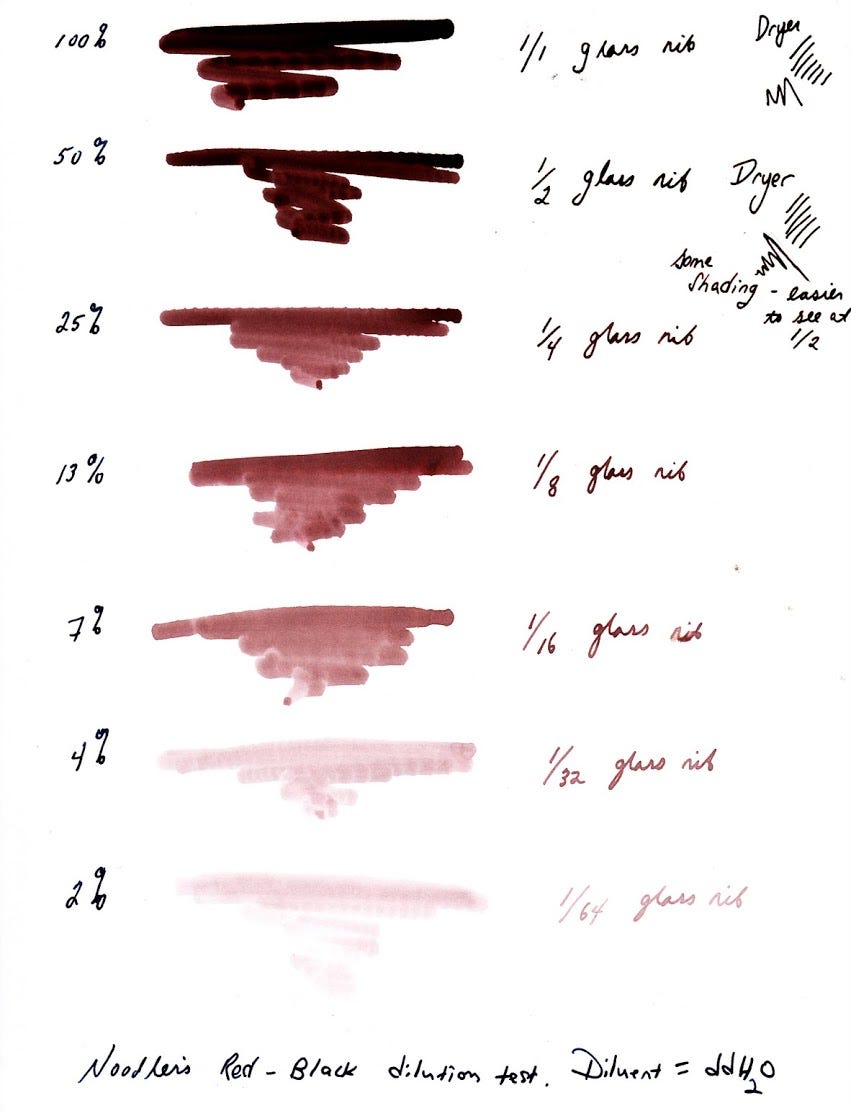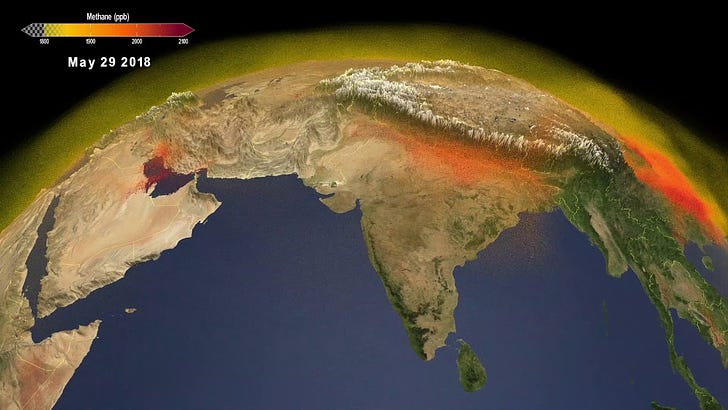Why is Methane Such a Powerful Greenhouse Gas?
Why a little bit of methane goes a long way in warming the planet
We need to talk about methane.
According to two recent studies, global methane levels are at an all-time high.
This is a problem because over 20 years, methane is 86 times as potent a greenhouse gas as carbon dioxide, meaning 1 tonne of methane absorbs as much heat over 20 years as 86 tonnes of carbon dioxide.
For context, this graph displays the concentration of methane in the atmosphere over the past 1000 years. Just like our carbon dioxide levels, methane levels are rising fast.

Meanwhile, the Trump Administration rolled back regulations requiring oil and gas companies to detect and seal methane leaks. This is a considerable setback as the US energy and agriculture industries are tied as the top two sources of domestic methane emissions.
One of the studies on global methane levels has a chart showing the largest sources of methane. Taken together, human activities now produce more methane than natural sources.

(The accompanying table has a detailed breakup and points out some interesting facts. For example, I had no idea that rice cultivation is a large source of methane emissions, or that termites produce so much methane.)
A Hidden Puzzle
But there’s a science question lurking here. What makes methane such a powerful greenhouse gas compared to carbon dioxide? Why do some greenhouse gases pack more of a global warming punch compared to others?
Scientists call a greenhouse gas’s power to warm the planet its global warming potential. And topping this list are greenhouse gases you might never have heard of (with names like carbon tetrafluoride or sulfur hexafluoride).
Pound for pound, these gases are many thousands of times more effective at warming the planet than carbon dioxide. Why?
The answer is surprisingly counter-intuitive: dilute greenhouse gases pack a larger global-warming punch. To see why, we need to view the world from the perspective of a beam of light.
Why A Little Bit Goes a Long Way
Earth receives energy from the Sun mainly in the form of visible light. The planet absorbs and then emits this energy into space via invisible infrared light (i.e. radiated heat). Greenhouse gases block some of this escaping infrared light, thereby trapping heat and warming the planet.

Just as there are different colors of visible light, there are different wavelengths of infrared light. One set of infrared light wavelengths are blocked by carbon dioxide. Another set of infrared wavelengths are blocked by water vapor. Yet another set of wavelengths are blocked by methane. Each greenhouse gas blocks different ‘colors’ of infrared light.
So picture a beam of infrared light trying to escape the Earth. The atmosphere extends for dozens of miles, so this beam of light has a long way to go.

Now let’s sprinkle in a greenhouse gas that can block this beam of light. If the concentration of the greenhouse gas is very, very low, it’s unlikely that the beam will encounter a greenhouse gas molecule.

As the air gets crowded with more molecules of this gas, it’s increasingly likely that the beam of light will hit one of them. This light beam ends up ricocheting back and forth like a ball in a pinball machine, and its trapped energy warms the Earth.

If you were to graph the chance of a collision versus the concentration of the greenhouse gas, it’d look something like this.

Initially, when the gas is very dilute, for every step up in concentration, there’s a steep rise in the odds of bumping into a molecule.
But as the gas becomes more abundant, collisions become very likely, and so the same increase in concentration now results in a small rise in the chance of a collision.

It’s a lot like how when you add a few drops of ink in water, the water quickly becomes murky. But with enough drops of ink, the water becomes almost opaque, and you get diminishing returns from every added drop.

Image: jandrese, Fountain Pen Network. Notice that initially, small changes in ink dilution result in a large change in opacity. So every successive drop of ink blocks less and less light.
Just as every successive drop of ink blocks less and less light, every additional amount of greenhouse gas blocks a little less of Earth’s escaping heat — you get diminishing returns on global warming.
Which means the most dilute greenhouse gases pack the largest global-warming punch. That’s because at low concentrations, it’s easier to make the atmosphere ‘murky’ with greenhouse gas. At high concentrations, the air becomes saturated with the greenhouse gas, and so it’s harder to make a noticeable change in ‘murkiness’.
Note: This does *not* mean that Earth will become insensitive to adding more CO2. Adding more of a greenhouse gas always makes it warmer, it just does so in increasingly smaller steps.
Although this simple model brushes over the messy complexities of heat absorption, it offers a valuable insight, known to climate scientists as the band saturation effect.
Methane is a powerful greenhouse gas mainly because it’s at a low concentration. While the concentration of CO2 in the atmosphere is well over 400 parts per million, the concentration of methane is currently under 2 parts per million.
Because of this difference in concentration, methane makes the atmosphere ‘murkier’ than carbon dioxide does (when seen from the perspective of escaping infrared light). And that’s why methane takes a bigger bite out of our escaping heat.
So when it comes to greenhouse gases, a little bit goes a long way. This is why we need to be especially careful about trace greenhouse gases like methane as well as the hydrofluorocarbons (HFCs) released by ACs and fridges.
Most of these fluorocarbons didn’t exist before humans synthesized them, so their concentration started from zero, which is precisely why they have such an outsized warming effect.
In a way, this can be viewed optimistically — if low concentrations of gas have an outsized effect on warming, it also means that we can have an outsized effect on curtailing global warming by reducing our emissions of trace greenhouse gases like methane and fluorocarbons.
For example, the climate solutions website Project Drawdown considers developing newer air-conditioning and refrigeration technologies as among the most impactful ways to take a bite out of global greenhouse emissions.
References
If you’re interested in learning more about the science of the greenhouse effect, check out our three part explainer. I also recommend David Archer’s lectures and accompanying textbook. This science in this post is based on his lecture on The Band Saturation Effect.
The Rate of Change takes an accessible look at the science of climate change. If you’re reading this online, you can subscribe to this newsletter below.
If you value these in-depth science explainers, please consider supporting my writing on Patreon. And thanks for reading!



I love the way your wrote this. However, I think you are missing important information to the reader. While you're article can largely be summed up with a study of "rate of change", "slope of a tangent line", "rise over run", etc., I think you are emphasizing the wrong graph. You have plotted the likelihood of collision, but don't give any weight to those collisions. You've eluded to it, and perhaps some readers with background knowledge will understand what you are saying, but most people don't know what colors, bands, or wavelengths of invisible light are, or what that even means. Perhaps expand your graphs with the potency of methane, CFCs, etc. as compared to CO2. Answer the question: why does methane trap more heat than CO2, pound for pound? Or, put another way, if CO2 and methane were equal parts in the atmosphere, which would cause more heat to be trapped? (Keep in mind, equal compound counts are not the same as equal weights of those compounds, so explain appropriately).
All in all, I like the direction, the graphics, and the analogies. I think this could be a great teaching article if it was expanded.